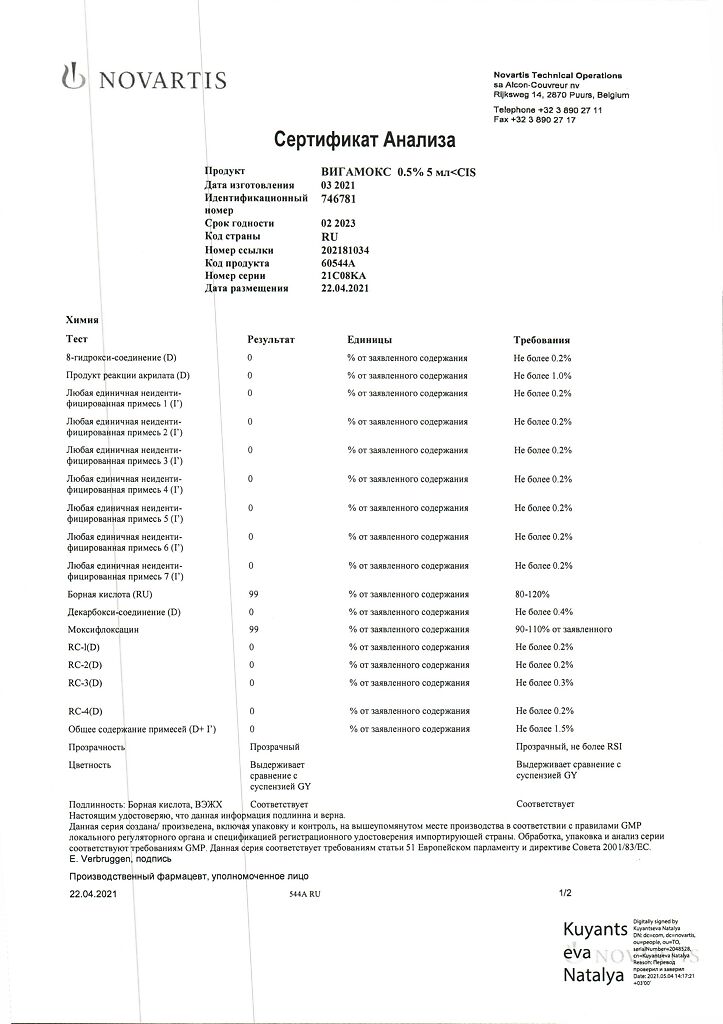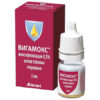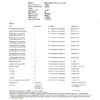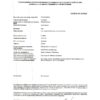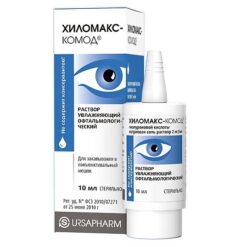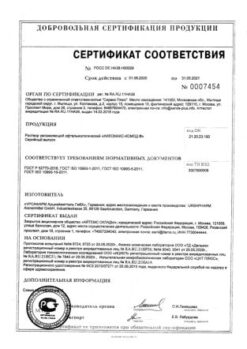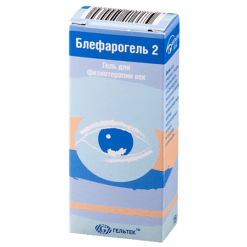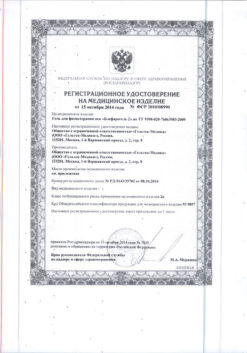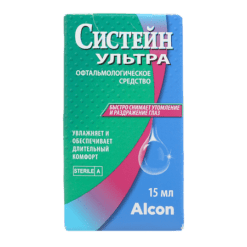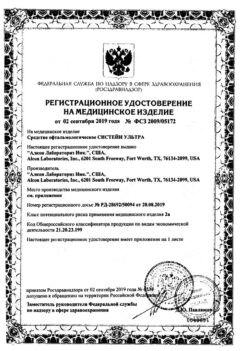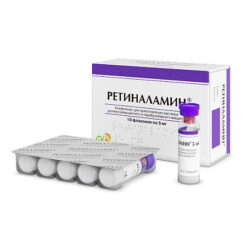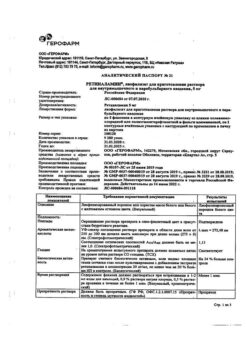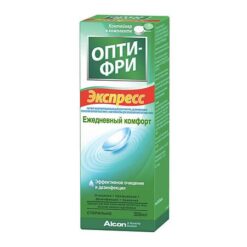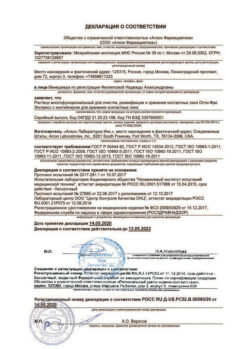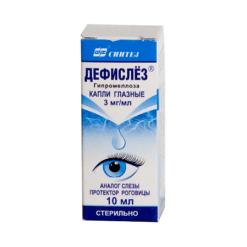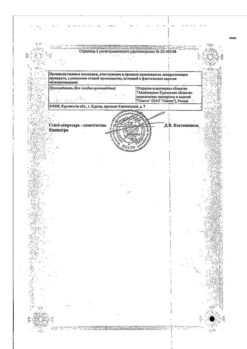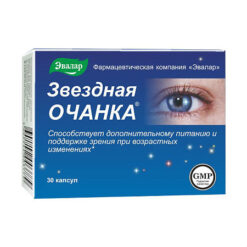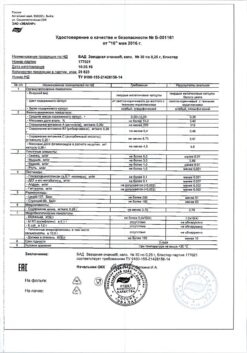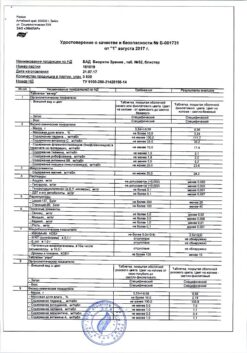No products in the cart.
Vigamox, eye drops 0.5% 5 ml
€6.31 €5.52
Description
Vigamox eye drops is a broad-spectrum antibacterial drug (group of fluoroquinolones) for local use in ophthalmology. The drug shows bactericidal activity against a large number of bacteria including staphylococci, streptococci, Escherichia coli, diphtheria pathogens, salmonella, mycoplasmas, chlamydia, gonococci, spirochetes, Klebsiella, including strains of microorganisms resistant to other groups of antibacterial drugs.
Moxifloxacin is active against most strains of microorganisms (both in vitro and in vivo):
Gram-positive bacteria: Corynebacterium spp, including Corynebacterium diphtheriae; Micrococcus luteus (including strains insensitive to erythromycin, gentamicin, tetracycline and/or trimethoprim); Staphylococcus aureus (including strains insensitive to methicillin, erythromycin, gentamicin, ofloxacin, tetracycline and/or trimethoprim); Staphylococcus epidermidis (including strains insensitive to methicillin, erythromycin, gentamicin, ofloxacin, tetracycline and/or trimethoprim); Staphylococcus haemolyticus (including strains insensitive to methicillin, erythromycin, gentamicin, ofloxacin, tetracycline and/or trimethoprim); Staphylococcus hominis (including strains insensitive to methicillin, erythromycin, gentamicin, ofloxacin, tetracycline and/or trimethoprim); Staphylococcus warneri (including strains insensitive to erythromycin); Streptococcus mitis (including strains insensitive to penicillin, erythromycin, tetracycline and/or trimethoprim); Streptococcus pneumoniae (including strains insensitive to penicillin, erythromycin, gentamicin, tetracycline and/or trimethoprim); Streptococcus viridans group (including strains insensitive to penicillin, erythromycin, tetracycline and/or trimethoprim).
Gram-negative bacteria: Acinetobacler Iwoffii; Haemophilus influenzae (including ampicillin-insensitive strains); Haemophilus parainfluenzae; Klebsiella spp.
Other microorganisms: Chlamydia trachomatis.
Moxifloxacin works in vitro against most of the following microorganisms, but the clinical significance of these data is unknown:
Gram-positive bacteria: Listeria monocytogenes; Staphylococcus saprophyticus; Streptococcus agalactiae; Streptococcus mitis; Streptococcus pyogenes; Streptococcus group C, G, F;
Gram-negative bacteria: Acinetobacler baumannii; Acinetobacter calcoaceticus; Citrobacter freundii; Citrobacter koseri; Enterobacter aerogenes; Enterobacter cloacae; Escherichia coli; Klebsiella oxytoca; Klebsiella pneumoniae; Moraxella catarrhalis; Morganella morganii; Neisseria gonorrhoeae; Proteus mirabilis; Proteus vulgaris; Pseudomonas stutzeri;
Anaerobic microorganisms: Clostridium perfringens; Fusobacterium spp.Prevotella spp.; Propionibacterium acnes.
Other organisms: Chlamydia pneumoniae; Legionella pneumophila; Mycobacterium avium; Mycobacterium marinum; Mycoplasma pneumoniae.
After instillation, it penetrates in small amounts into the systemic bloodstream; penetration into breast milk is possible, but the possibility of systemic action of the drug when used as directed is negligible.
Vigamox eye drops have a fast and prolonged therapeutic effect: the drug starts working 10-15 minutes after application and the duration of bactericidal effect is 6-8 hours.
Pharmacokinetics
When applied topically there is systemic absorption of moxifloxacin: Cmax is 2.7 ng/ml, AUC value is 45 ng×h/ml. These values are approximately 1600 and 1000 times lower than the Cmax and AUC after a therapeutic dose of moxifloxacin 400 mg by oral administration. T1/2 of moxifloxacin from plasma is about 13 hours.
Indications
Indications
for the treatment of inflammatory diseases of the anterior parts of the eye (including conjunctivitis, blepharitis, keratitis, corneal ulcers, dacryocystitis, meibomyitis, barley), which were caused by microorganisms sensitive to moxifloxacin;
for the prevention and treatment of bacterial eye inflammation resulting from eye injuries or after eye surgery.
Pharmacological effect
Pharmacological effect
Vigamox eye drops are a broad-spectrum antibacterial drug (fluoroquinolone group) for topical use in ophthalmology. The drug exhibits a bactericidal effect against a large number of bacteria, including staphylococci, streptococci, E. coli, diphtheria, salmonella, mycoplasma, chlamydia, gonococci, spirochetes, Klebsiella, including strains of microorganisms resistant to other groups of antibacterial drugs.
Moxifloxacin is active against most strains of microorganisms (both in vitro and in vivo):
Gram-positive bacteria: Corynebacterium spp., including Corynebacterium diphtheriae; Micrococcus luteus (including strains insensitive to erythromycin, gentamicin, tetracycline and/or trimethoprim); Staphylococcus aureus (including strains insensitive to methicillin, erythromycin, gentamicin, ofloxacin, tetracycline and/or trimethoprim); Staphylococcus epidermidis (including strains insensitive to methicillin, erythromycin, gentamicin, ofloxacin, tetracycline and/or trimethoprim); Staphylococcus haemolyticus (including strains insensitive to methicillin, erythromycin, gentamicin, ofloxacin, tetracycline and/or trimethoprim); Staphylococcus hominis (including strains insensitive to methicillin, erythromycin, gentamicin, ofloxacin, tetracycline and/or trimethoprim); Staphylococcus warneri (including strains insensitive to erythromycin); Streptococcus mitis (including strains insensitive to penicillin, erythromycin, tetracycline and/or trimethoprim); Streptococcus pneumoniae (including strains insensitive to penicillin, erythromycin, gentamicin, tetracycline and/or trimethoprim); Streptococcus viridans group (including strains insensitive to penicillin, erythromycin, tetracycline and/or trimethoprim).
Gram-negative bacteria: Acinetobacler Iwoffii; Haemophilus influenzae (including strains insensitive to ampicillin); Haemophilus parainfluenzae; Klebsiella spp.
Other microorganisms: Chlamydia trachomatis.
Moxifloxacin is active in vitro against most of the following microorganisms, but the clinical significance of these data is unknown:
Gram-positive bacteria: Listeria monocytogenes; Staphylococcus saprophyticus; Streptococcus agalactiae; Streptococcus mitis; Streptococcus pyogenes; Streptococcus groups C, G, F;
Gram-negative bacteria: Acinetobacler baumannii; Acinetobacter calcoaceticus; Citrobacter freundii; Citrobacter koseri; Enterobacter aerogenes; Enterobacter cloacae; Escherichia coli; Klebsiella oxytoca; Klebsiella pneumoniae; Moraxella catarrhalis; Morganella morganii; Neisseria gonorrhoeae; Proteus mirabilis; Proteus vulgaris; Pseudomonas stutzeri;
Anaerobic microorganisms: Clostridium perfringens; Fusobacterium spp.; Prevotella spp.; Propionibacterium acnes.
Other organisms: Chlamydia pneumoniae; Legionella pneumophila; Mycobacterium avium; Mycobacterium marinum; Mycoplasma pneumoniae.
After instillation, it penetrates into the systemic bloodstream in small quantities; penetration into breast milk is possible, but the likelihood of a systemic effect of the drug when used according to the instructions is negligible.
Vigamox eye drops are characterized by a rapid and long-lasting therapeutic effect: the drug begins to act 10-15 minutes after application, while the duration of the bactericidal effect is 6-8 hours.
Pharmacokinetics
When applied topically, moxifloxacin is systemically absorbed: Cmax is 2.7 ng/ml, AUC value is 45 ng×h/ml. These values are approximately 1600 times and 1000 times less than the Cmax and AUC after a therapeutic dose of moxifloxacin 400 mg orally. T1/2 of moxifloxacin from plasma is about 13 hours.
Special instructions
Special instructions
In patients using systemic quinolone drugs, severe, in some cases fatal, hypersensitivity reactions (anaphylaxis) were observed, sometimes immediately after taking the first dose (!).
Some reactions were accompanied by collapse, loss of consciousness, angioedema (including swelling of the larynx and/or face), airway obstruction, shortness of breath, urticaria and pruritus. If the above conditions occur, resuscitation measures may be required.
Long-term use of an antibiotic can lead to excessive growth of non-susceptible microorganisms, including fungi. In case of superinfection, it is necessary to discontinue the drug and prescribe adequate therapy.
Do not touch the tip of the dropper bottle to any surface to avoid contamination of the bottle and its contents. The bottle must be closed after each use.
Impact on the ability to drive vehicles and operate machinery
After using the drug, a temporary decrease in the clarity of visual perception is possible, and until it is restored, it is not recommended to drive a car or engage in activities that require increased attention and reaction.
Active ingredient
Active ingredient
Moxifloxacin
Composition
Composition
1 ml – moxifloxacin 5 mcg.
Excipients:
sodium chloride,
boric acid,
hydrochloric acid and/or sodium hydroxide (to adjust pH),
purified water.
Pregnancy
Pregnancy
Contraindicated:
Pregnancy.
Lactation (breastfeeding period).
There is no sufficient experience with the use of the drug during pregnancy and lactation.
The use of the drug during pregnancy (FDA category C) is possible only if the expected therapeutic effect for the mother exceeds the potential risk for the fetus and child.
Vigamox can pass into breast milk, and therefore breastfeeding should be discontinued during treatment with the drug.
Teratogenicity
In preclinical animal studies, moxifloxacin was not teratogenic at doses of 500 mg/kg/day (approximately 21,700 times the recommended daily dose for humans). However, there was a slight decrease in fetal body weight and delayed development of the musculoskeletal system. At a dose of 100 mg/kg/day, an increase in the incidence of decreased growth in newborns was noted.
Contraindications
Contraindications
Hypersensitivity to any of the components of the drug or to other quinolones.
Children and adolescents up to 1 year. Pregnancy. Lactation (breastfeeding period).
Side Effects
Side Effects
Local. In 1-10% of cases – pain, irritation and itching in the eye, dry eye syndrome, conjunctival hyperemia, eye hyperemia. In 0.1-1% of cases – a defect in the corneal epithelium, punctate keratitis, subconjunctival hemorrhage, conjunctivitis, swelling of the eye, discomfort in the eyes, blurred vision, decreased visual acuity, erythema of the eyelids, unusual sensations in the eye.
System. In 1-10% of cases – dysgeusia. In 0.1-1% of cases – headache, paresthesia, decreased blood hemoglobin, discomfort in the nose, pharyngolaryngeal pain, sensation of a foreign body in the throat, vomiting, increased levels of ALT and GGT.
Post-marketing experience (frequency unknown):
Local: endophthalmitis, ulcerative keratitis, corneal erosion, formation of corneal defects, increased intraocular pressure, corneal opacities, corneal infiltrates, deposits on the cornea, allergic reactions of the eye, keratitis, corneal edema, photophobia, blepharitis, eyelid edema, increased lacrimation, eye discharge, sensation of a foreign body in the eye.
Systemic: palpitations, dizziness, shortness of breath, nausea, erythema, rash, itching of the skin, hypersensitivity.
The occurrence of an allergic reaction requires discontinuation of the drug!
In patients using systemic quinolone drugs, including moxifloxacin, hypersensitivity reactions (anaphylaxis) were observed, including immediately after taking the first dose – collapse, loss of consciousness, Quincke’s edema, airway obstruction, shortness of breath, itching, rash.
Overdose
Overdose
If excess amounts of the drug get into your eyes, it is recommended to rinse your eyes with warm water.
Storage conditions
Storage conditions
At 2–25 °C
Shelf life
Shelf life
2 years
Manufacturer
Manufacturer
Alcon-Couvreur, Belgium
Additional information
| Shelf life | 2 years |
|---|---|
| Conditions of storage | At 2-25 °C |
| Manufacturer | Alcon-Couvreur, Belgium |
| Medication form | eye drops |
| Brand | Alcon-Couvreur |
Related products
Buy Vigamox, eye drops 0.5% 5 ml with delivery to USA, UK, Europe and over 120 other countries.


